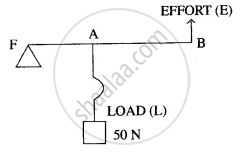Advertisements
Advertisements
प्रश्न
The lever for which the mechanical advantage is less than 1 has :
पर्याय
Fulcrum at mid-point between load and effort.
Load between effort and fulcrum.
Effort between fulcrum and load.
Load and effort acting at the same point.
उत्तर
Effort between fulcrum and load.
Reason:
Levers, for which the mechanical advantage is less than 1, always have the effort arm shorter than the load arm.
APPEARS IN
संबंधित प्रश्न
What is a lever?
Class II levers are designed to have ______.
A 4 m long rod of negligible weight is to be balanced about a point 125 cm from one end and a load of 18 kgf is suspended at a point 60 cm from the support on the shorter arm.
- If a weight W is placed at a distance of 250 cm from the support on the longer arm to balance the rod, find W.
- If a weight 5 kgf is kept to balance the rod, find its position.
- To which class of lever does it belong?
Give three examples for leavers of second order.
The following belong to which class of lever?
An oar of a boat
The following belong to which class of lever?
Sugar tongs
The following belong to which class of lever?
Nutcracker
The following belong to which class of lever?
Fore-arm
The diagram below shows a lever in use.

(i) To which class of lever does it belong?
(ii) If FA = 40 cm, AB = 60 cm, then find the mechanical advantage of the lever.
A lever is used to multiply the force.
